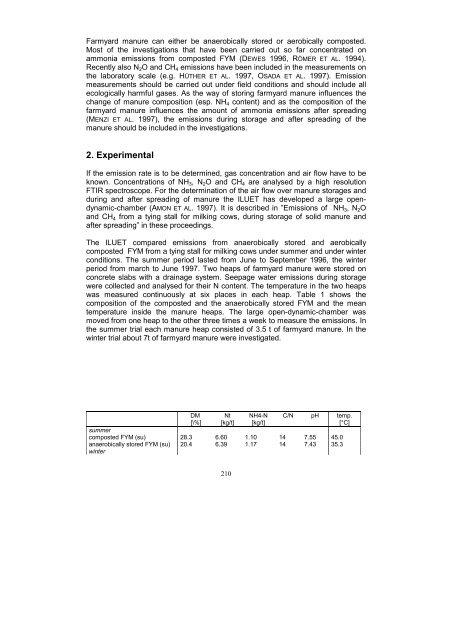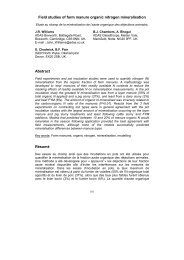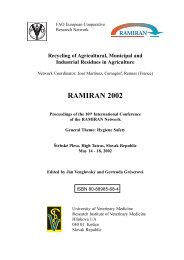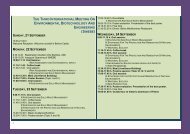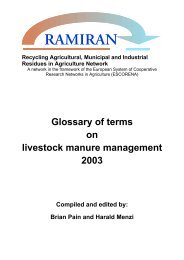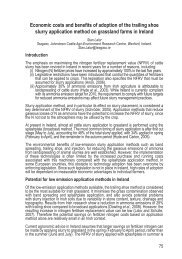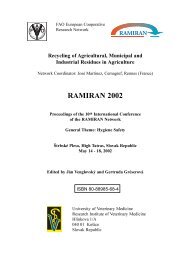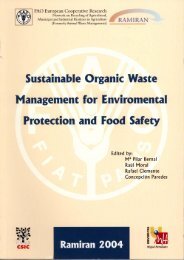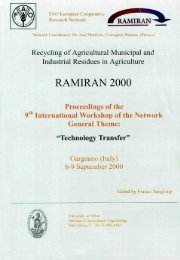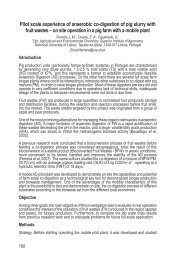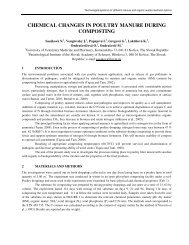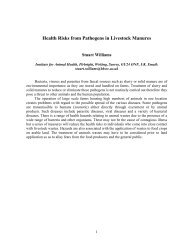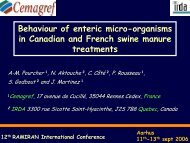Emissions of NH3, N2O and CH4 from composted and ... - Ramiran
Emissions of NH3, N2O and CH4 from composted and ... - Ramiran
Emissions of NH3, N2O and CH4 from composted and ... - Ramiran
Create successful ePaper yourself
Turn your PDF publications into a flip-book with our unique Google optimized e-Paper software.
Farmyard manure can either be anaerobically stored or aerobically <strong>composted</strong>.<br />
Most <strong>of</strong> the investigations that have been carried out so far concentrated on<br />
ammonia emissions <strong>from</strong> <strong>composted</strong> FYM (DEWES 1996, RÖMER ET AL. 1994).<br />
Recently also N 2 O <strong>and</strong> CH 4 emissions have been included in the measurements on<br />
the laboratory scale (e.g. HÜTHER ET AL. 1997, OSADA ET AL. 1997). Emission<br />
measurements should be carried out under field conditions <strong>and</strong> should include all<br />
ecologically harmful gases. As the way <strong>of</strong> storing farmyard manure influences the<br />
change <strong>of</strong> manure composition (esp. NH 4 content) <strong>and</strong> as the composition <strong>of</strong> the<br />
farmyard manure influences the amount <strong>of</strong> ammonia emissions after spreading<br />
(MENZI ET AL. 1997), the emissions during storage <strong>and</strong> after spreading <strong>of</strong> the<br />
manure should be included in the investigations.<br />
2. Experimental<br />
If the emission rate is to be determined, gas concentration <strong>and</strong> air flow have to be<br />
known. Concentrations <strong>of</strong> NH 3 , N 2 O <strong>and</strong> CH 4 are analysed by a high resolution<br />
FTIR spectroscope. For the determination <strong>of</strong> the air flow over manure storages <strong>and</strong><br />
during <strong>and</strong> after spreading <strong>of</strong> manure the ILUET has developed a large opendynamic-chamber<br />
(AMON ET AL. 1997). It is described in ”<strong>Emissions</strong> <strong>of</strong> NH 3 , N 2 O<br />
<strong>and</strong> CH 4 <strong>from</strong> a tying stall for milking cows, during storage <strong>of</strong> solid manure <strong>and</strong><br />
after spreading” in these proceedings.<br />
The ILUET compared emissions <strong>from</strong> anaerobically stored <strong>and</strong> aerobically<br />
<strong>composted</strong> FYM <strong>from</strong> a tying stall for milking cows under summer <strong>and</strong> under winter<br />
conditions. The summer period lasted <strong>from</strong> June to September 1996, the winter<br />
period <strong>from</strong> march to June 1997. Two heaps <strong>of</strong> farmyard manure were stored on<br />
concrete slabs with a drainage system. Seepage water emissions during storage<br />
were collected <strong>and</strong> analysed for their N content. The temperature in the two heaps<br />
was measured continuously at six places in each heap. Table 1 shows the<br />
composition <strong>of</strong> the <strong>composted</strong> <strong>and</strong> the anaerobically stored FYM <strong>and</strong> the mean<br />
temperature inside the manure heaps. The large open-dynamic-chamber was<br />
moved <strong>from</strong> one heap to the other three times a week to measure the emissions. In<br />
the summer trial each manure heap consisted <strong>of</strong> 3.5 t <strong>of</strong> farmyard manure. In the<br />
winter trial about 7t <strong>of</strong> farmyard manure were investigated.<br />
DM Nt NH4-N C/N pH temp.<br />
[\%] [kg/t] [kg/t] [°C]<br />
summer<br />
<strong>composted</strong> FYM (su) 28.3 6.60 1.10 14 7.55 45.0<br />
anaerobically stored FYM (su) 20.4 6.39 1.17 14 7.43 35.3<br />
winter<br />
210


